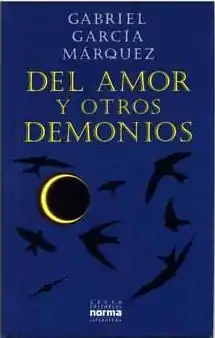Of Love and Other Demons
Of Love and Other Demons (Spanish: Del amor y otros demonios) is a novel by Colombian author Gabriel García Márquez, first published in 1994.
 First edition (Colombia) | |
| Author | Gabriel García Márquez |
|---|---|
| Original title | Del amor y otros demonios |
| Translator | Edith Grossman |
| Country | Colombia |
| Language | Spanish |
| Publisher | Grupo Editorial Norma (Colombia) Alfred A. Knopf (US) |
Publication date | 1994 |
In the prologue, García Márquez claims the novel is the fictional representation of a legend the author was told by his mother when he has 14 years old: of a 12-year-old girl who contracts rabies but was believed to be a 'miracle-worker', with long flowing copper hair that continues to grow after death. In this frame-story, it was only after an excavation of tombs that García Márquez is witness to the grave of a similar young girl with long red hair still attached to the skull, that he was inspired to write Of Love and Other Demons.
Mariana Solanet, however, in García Márquez for Beginners, states this source was invented. She points rather to a story in Eduardo Lemaitre's History of Cartagena that García Márquez came across in research for Love in the Time of Cholera.[1]
In 2008, the opera Love and Other Demons, by Hungarian composer Péter Eötvös was premiered at the Glyndebourne Festival.
Plot
Sierva Maria de Todos Los Angeles
Sierra is the twelve-year-old daughter of the Marquis and his wife Bernarda. Her hair has never been cut, and was promised to the saints when she was born with the umbilical cord around her neck. She was raised by the slaves, fluent in multiple African languages, and familiar with the customs. In the beginning of the book she is bit by a rabid dog. Even though she shows no signs of rabies, she is subject to multiple "healing" methods, which can be considered torture. She is sent to the convent of Santa Clara to receive an exorcism, which many people have died from. She receives attention from a priest, Father Cayetano, who is kind to her and initially believes she does not need to be exorcised. Father Cayetano falls in love with Sierva Maria and declares her his love; he soon begins visiting Sierva in her cell in secret, climbing up from the sewer (that in future is fixed). They eat, sleep, and recite poetry together, even though it does not appear that they are sexually involved. Later Father Cayetano is sent away to a leper hospital where he hopes to get the disease but never does. Sierva Maria in the meantime is last summoned to be exorcised and she eventually dies 'of love' wondering where Father Cayetano is and after having her hair cut. After her death, her hair magically grows back on her skull.
Film
References
- Solanet 2001, p. .
Sources
- Solanet, Mariana (2001). García Márquez for Beginners. New York: Writers and Readers.CS1 maint: ref=harv (link)